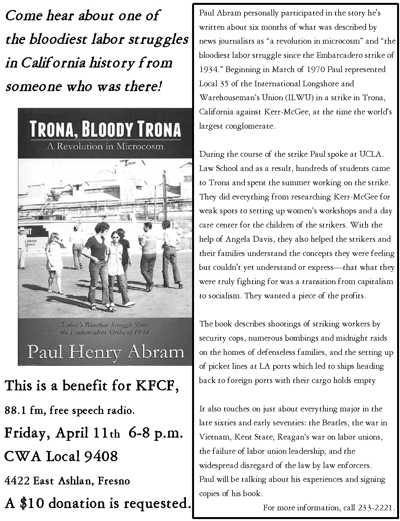I recently ran across an article in the Ridgecrest News Review, Community of Trona, the home of several museums by Laura Quezada. One of the things Laura mentions in her article was the Tufa House that was donated to the Searles Valley Historical Society by Robert Schuette. This caught my interest because I had never heard of the Tufa House before but I have heard the name, Schuette, (pronounced “Shooty”) so I sent Bill Schuette, class of 1958, an email to ask him what he knew about the Tufa House.
Bill wrote back and told me that the house was once owned by his grandmother from 1943 to 1960 and that originally it was on homesteaded land on the other side of the Argus Range that was taken over by the Navy when they took over the airfield from the Army Air Force and expanded it into a ordinance testing area.
Henry F. W. Schuette moved the Schuette family from the Los Angeles area to Inyokern, near China Lake, sometime between 1916 and 1930. He worked on the Los Angeles aqueduct project. Henry F. W. and his wife, Johanna, were granted a homestead (by the US government) near of the railroad head known as Brown, on China Lake. In the 1920 US Census Henry is listed as a famer with a stock ranch in Kern county. By 1930 the family had moved to Inyo to an area was described as Township 4 in the 1930 US census. In researching BLM land records I found that Henry homesteaded 160 acres of land in 1916. I will have to do more research because it is common for additional homestead land to be acquired by other family members.
Henry and Johanna had five children: George, Mildred, Henry, Emily and Frederick. Henry F. W. and his children worked the homestead together during the great depression years. He was employed by the Westend Chemical plant on Searle’s Lake, 25 miles from China Lake. Henry died from appendicitis in 1941. The family continued to improve the homestead until the US government took the property by eminent domain to build the Naval Ordinance Test Station on China Lake. This became a weapons test site for Cal Tech during and after WWII. The Rock House, built by the Schuette’s, was moved from the homestead (by the US government) to its current Argus location in Searle’s Valley.
What is made of? I’m eager to find out. Perhaps the SVHS can ask someone for the Searles Lake Gem and Mineral Society to examine it. Its appearance in the photo makes me think it is Tufa.
I have much more research to do so check back to learn what I find.










 I have meet a lot of lawyers who work on social and economic justice issues but have never met one quite like Paul Henry Abram. I look forward to his visit to Fresno on Friday, when he will appear in a benefit for listener sponsored radio station KFCF (see details below). Abram has written an extraordinary account of his experience representing the union members in ILWU local 35 who were on strike in Trona Ca in 1970. Most lawyers are more cautious (some would say conservative) than the activists they represent, but Abram gains the trust of the workers by being as militant as they are and willing to share the risks needed to win.
I have meet a lot of lawyers who work on social and economic justice issues but have never met one quite like Paul Henry Abram. I look forward to his visit to Fresno on Friday, when he will appear in a benefit for listener sponsored radio station KFCF (see details below). Abram has written an extraordinary account of his experience representing the union members in ILWU local 35 who were on strike in Trona Ca in 1970. Most lawyers are more cautious (some would say conservative) than the activists they represent, but Abram gains the trust of the workers by being as militant as they are and willing to share the risks needed to win.




